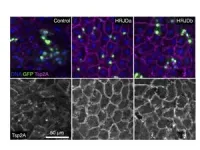(Press-News.org)
When developing new drugs, understanding their effects on ion channels in the body, such as the human ether-a-go-go-related gene (hERG) ion channel found in neurons and heart muscle cells, is critical. Blocking hERG channels can disrupt normal heart rhythm, potentially leading to a fatal condition known as torsade de pointes. Current methods for assessing these effects typically involve invasive procedures like patch-clamp techniques or fluorescence microscopy. These methods alter cell properties and may affect measurement accuracy, requiring specialized equipment and expertise, which increases cost and complexity.
To address these challenges, researchers led by Daisuke Kawashima, an Assistant Professor at the Graduate School of Engineering at Chiba University, have proposed a novel, non-invasive method for real-time evaluation of drug effects on hERG channels. They developed a printed circuit board (PCB) sensor integrating electrical impedance tomography (EIT) with extracellular voltage activation (EVA). EIT measures impedance changes caused by ion movement, offering spatial information about extracellular ion distribution. EVA involves applying controlled extracellular voltages to induce changes in ion channel activity. This integrated approach allows researchers to non-invasively activate hERG channels and monitor real-time ion flow changes in response to drug exposure.
The study was published in the journal Lab on A Chip on May 23, 2024. It included contributions from Assistant Professor Songshi Li and Professor Masahiro Takei from the Graduate School of Engineering, Chiba University, along with Associate Professor Satoshi Ogasawara and Professor Takeshi Murata from the Graduate School of Science, Chiba University.
"This imaging technique is expected to serve as a new measurement and evaluation technology platform for medical and drug discovery," says Dr. Kawashima.
The EIT–EVA PCB sensor is made from non-conductive epoxy glass fiber (FR-4 TG130) and measures 100 mm × 70 mm × 1.6 mm. It has 16 electrodes for EIT measurement arranged around a central activation electrode for EVA activation. Here's how it works: The cells under investigation for drug effects on ion channels are placed on the sensor. A step voltage is applied to the activation electrode, which changes potential distribution in the extracellular medium surrounding the cells. This change affects the cell membrane potential, activating voltage-gated ion channels like the hERG channels. When these channels open, potassium ions move out of the cells, changing the extracellular resistance, which is measured by the EIT system.
The drug's effect on the ion channel is then observed by monitoring changes in extracellular conductivity. If the hERG channels are not blocked by the drug, the concentration of potassium ions outside the cells increases quickly. However, if the drug blocks the channels, this increase slows down. The system calculates an inhibitory ratio index (IR) by measuring how fast the extracellular ion concentration changes over time, showing how much the drug inhibits the hERG channels.
To test their method, researchers exposed suspensions of genetically modified HEK 293 cells with hERG channels to the antiarrhythmic drug E-4031 at various concentrations (0 nM, 1 nM, 3 nM, 10 nM, 30 nM, and 100 nM). After mixing the drug and cell suspension into the sensor using a micropipette, they conducted baseline EIT measurements for 20 seconds to establish a baseline for ion movement. Subsequently, they alternated 20-second cycles of EVA activation and EIT measurements.
When the hERG channels were activated by EVA, the extracellular resistance decreased compared to the baseline (due to an increase in potassium ion concentration). However, as the concentration of E-4031 increased and blocked the hERG channels, fewer potassium ions were transported from the intracellular region to the extracellular region, resulting in a slower decrease in resistance.
From the IR response curve, the researchers found that the half-maximal inhibitory concentration or the concentration of drug required to inhibit hERG channel function by 50% was 2.7 nM. This value shows a strong correlation (R2 = 0.85) with results obtained from the established patch-clamp method, indicating close agreement between the two techniques. Compared to traditional methods in hERG channel screening, the proposed method is non-invasive, has a fast response time, and does not require special training. "This can lead to more efficient and shorter preclinical testing in the drug discovery process," concludes Dr. Kawashima.
About Assistant Professor Daisuke Kawashima
Daisuke Kawashima received the B.S., M.S., and Ph.D. degrees in Mechanical Engineering from Tokyo Metropolitan University in Japan in 2012, 2014, and 2017, respectively. In 2017, he joined Chiba University in Japan as a Postdoctoral Fellow. He currently serves as an Assistant Professor at the Graduate School of Engineering. Prof. Kawashima has published over 40 research papers, which have been cited 250 times. His research interests include mass transfer in cells/tissues, electrical spectral analysis, and electrical tomographic imaging applied to biomedical and industrial fields.
END
Much of the water in the West is transported across vast geographical areas by large infrastructure projects known as interbasin water transfers. Two of these projects in particular make up 85% of all energy-related greenhouse gas emissions associated with U.S. interbasin transfers — one in Arizona and the other in California — according to the new research published this week in the journal Nature Water.
The project in Arizona is known as the Central Arizona Project and in California it’s the State Water Project.
“You hear a lot about these big projects and how much energy they use,” said Avery Driscoll, a doctoral student in ...
Higher levels of urinary metals such as cadmium, tungsten, uranium, cobalt, copper and zinc are linked to increased cardiovascular disease and mortality in a racially and ethnically diverse U.S. population, according to a new study at Columbia University Mailman School of Public Health. While it is well documented that exposure to certain metals has been associated with cardiovascular disease (CVD) and mortality, until now the evidence was limited beyond arsenic, cadmium, and lead and for a racially diverse population. The findings are published in the journal Circulation.
When analyzed together, ...
Human-made climate change can lead to a destabilisation of large-scale components of the Earth system such as ice sheets or ocean circulation patterns, the so-called tipping elements. While these components will not tip over night, fundamental processes are put into motion unfolding over tens, hundreds or thousands of years. These changes are of such a serious nature that they should be avoided at all costs, the researchers argue. In their new study, they assessed the risks of destabilisation of at least one ...
For some forms of tuberculosis, the chances that an exposed person will get infected depend on whether the individual and the bacteria share a hometown, according to a new study comparing how different strains move through mixed populations in cosmopolitan cities.
Results of the research, led by Harvard Medical School scientists and published Aug. 1 in Nature Microbiology, provide the first hard evidence of long-standing observations that have led scientists to suspect that pathogen, place, and human host ...
LA JOLLA, CA—To diagnose heart conditions including heart attacks and heart rhythm disturbances, clinicians typically rely on 12-lead electrocardiograms (ECGs)—complex arrangements of electrodes and wires placed around the chest and limbs to detect the heart’s electrical activity. But these ECGs require specialized equipment and expertise, and not all clinics have the capability to perform them.
Now, a team of scientists and clinicians from Scripps Research has shown that heart conditions can be diagnosed roughly as accurately using just three electrodes and an artificial intelligence (AI) tool. In a ...
Current climate policies imply a high risk for tipping of critical Earth system elements, even if temperatures return to below 1.5°C of global warming after a period of overshoot. A new study indicates that these risks can be minimized if warming is swiftly reversed.
Human-made climate change can lead to a destabilization of large-scale components of the Earth system such as ice sheets, ocean circulation patterns, or global biosphere components, the so-called tipping elements. In their new study published in Nature Communications, researchers from IIASA and the Potsdam Institute for Climate Impact Research (PIK) analyzed the risks for four interconnected core climate tipping elements ...
Vaccines are safe and effective, and help reduce death and illness. But global vaccination rates are suboptimal and have trended downward, leaving humanity more vulnerable to vaccine-preventable diseases such as COVID-19, influenza, measles, polio, and HPV.
Identifying interventions that could increase vaccine coverage could help save lives. A new paper from a team led by researchers at the University of Pennsylvania offers the first comprehensive meta-analysis examining what types of vaccine intervention strategies have the ...
Osaka, Japan — An aging society has posed a new global problem, the risk of falling. It is estimated that 1 in 3 adults over the age of 65 falls each year and the resulting injuries are becoming more prevalent.
To tackle this growing issue, Associate Professor Hiromitsu Toyoda and Specially Appointed Professor Tadashi Okano from Osaka Metropolitan University’s Graduate School of Medicine, together with Professor Chisato Hayashi from the University of Hyogo, have developed a formula and assessment tool for estimating fall risks that is simple for older adults to use. The tool was developed using data collected from older adults over a ten-year period from April 2010 to December ...
Resistance, or weight training, is widely recommended in sports and rehabilitation as an effective exercise to increase muscular strength and size. This form of exercise involves applying resistance to muscle contraction to build strength. However, some practitioners believe resistance training can increase passive muscle stiffness over time. Passive muscle stiffness is a key indicator of how muscles behave mechanically when they are stretched without active contraction. Specifically, it refers to the amount of force required to change the muscle length by a given amount during passive stretching. Studies ...
Image cropping is an essential task in many contexts, right from social media and e-commerce to advanced computer vision applications. Cropping helps maintain image quality by avoiding unnecessary resizing, which can degrade the image and consume computational resources. It is also useful when an image needs to conform to a predetermined aspect ratio, such as in thumbnails. Over the past decade, engineers around the world have developed various machine learning (ML) models to automatically crop images. These models aim to crop an input image in a way that preserves its most relevant parts.
However, ...






